The Movies of Fu Manchu:
Part One:

First played by Harry Agar Lyons in the 1920's, the sinister Chinese doctor was
subsequently portrayed in the movies by Warner Oland, Boris Karloff, Henry Brandon,
Manuel Requena, Christopher Lee and Peter Sellers. John Carradine and Glen Gordon
portrayed Fu Manchu on television. Rohmer's sinister female, Sumuru, had her movies as well.

 Part One:
Part One:
Part Three: Henry Brandon and Manuel Requena
Part Four: Christopher Lee and Peter Sellers

1914: Mr. Wu Chung Fu
|
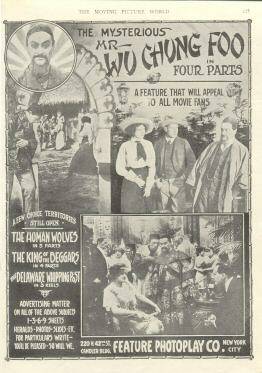
Advertisement from Moving
Picture World, 1914
|
While "The Mysterious Wu Chung Foo--A Feature That
Will Appeal To All Movie Fans" never officially acknowledges its
origins and Rohmer was given no credit (or payment) Fu
Manchu and Rohmer's plot elements are clearly found in this four-part silent
serial movie appearing July 1914 from the Feature Photoplay Company in New
York City. The plot, as summarized by the American Film
Institute, leaves little doubt as to its pedigree:
"After a game of cards at the Astor Club, Lord
Lister, a detective, notices an inscription on a dollar bill which reads,
'We are held prisoners by a Chinese gang at Cosia,
near Sacramento. Send help!' Lister and his
friend, Charles Brand, determined to unravel this mystery, travel to Cosia
where they encounter the mysterious Chinese merchant Wu Chung Foo. Wu Chung
tells Lister and Brand |
|
about the unexplained disappearances
of many men on his grounds. At Wu Chung's home, his adopted daughter
Hattie's attraction to Brand angers the merchant into having him secretly
taken to his underground prison where men are worked to death. Lister's
suspicions about Brand's disappearance force Wu Chung to have the detective
taken there as well. Hattie discovers the secret and gets help from some
soldiers who capture Wu Chung and release Brand and the others."
AFI Catalog of Feature Films.
29 December 2005. |
1921: The Yellow Claw
(Feature; BFI 6118 feet; 1837.02 m (6 reels, USA))
Featuring Fu Manchu’s prototype, "Mr. King," it was the first
movie explicitly based on Sax Rohmer’s work.
| Production company: |
Stoll |
| Director: |
René Plaisetty |
| Screenplay: |
Gerald Fort Buckle |
| Art direction: |
Walter W. Murton |
| Photography: |
John J. Cox |
Players:
| A. C. Fotheringham-Lyons |
Henry Leroux |
| Ivy King |
Mrs. Leroux |
| Kitty Fiedler |
Lady of the Poppies |
| Norman Page |
Soames |
| Harvey Braban |
Gaston Max |
| Sydney Seaward |
Inspector Dunbar |
| Kiyoshi Takase |
Ho-Pin |
| Mary Massart |
Helen Cumberley |
| Cyril Percival |
John Howard Edel |
| Arthur M. Cullin |
Dr. Cumberley |
| Annie Esmond |
Denise Ryland |
| June |
Mrs. Vernon (The Lady of the Civet Furs) |
| Eric Albury |
Gianopolis |
| Geoffrey Benstead |
Sowerby |
| George Harrington |
|
| Iris Macki |
|
1923: The Mystery of Fu Manchu
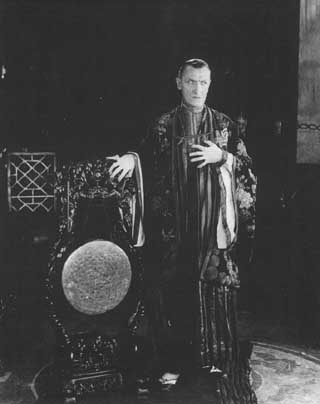
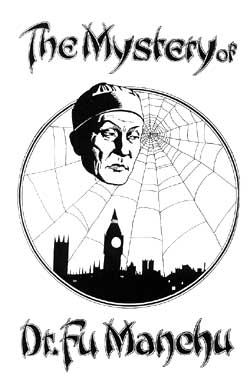
Photo and "campaign piece" from the collection of John Soister.
Used with permission.
"In the Underground stations, all over London, larger
than life sized posters depicted the leering visage and
clutching hands of the Devil Doctor."
(Master of Villainy, p. 157)
|
A series of twenty-five cards were printed and distributed
in cigarette packs. They were variously tinted green,
brown,
or blue.
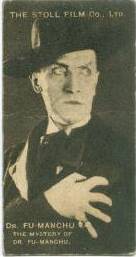
No.1
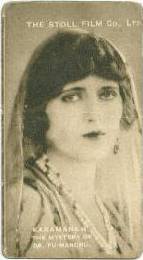
No. 2
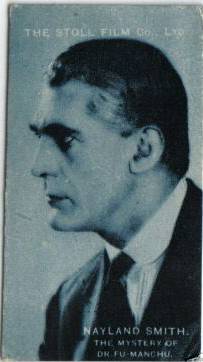

No.3 featuring Fred P. Paul as Nayland Smith
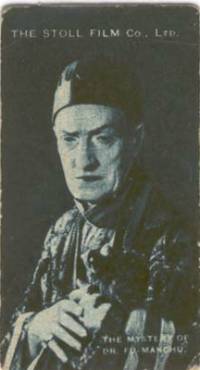

No. 4 featuring Harry Agar Lyons as Dr. Fu-Manchu

No. 5
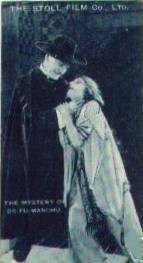

No. 6
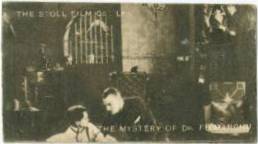
No. 7

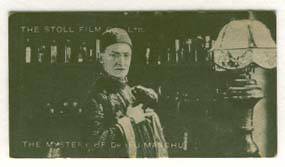
No. 8
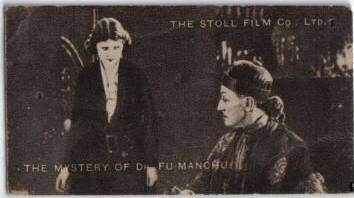
No. 9
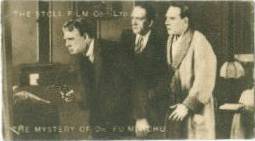
No. 10
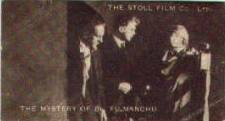
No. 11
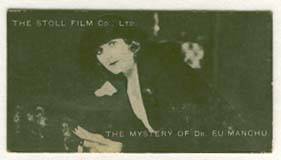
No. 12
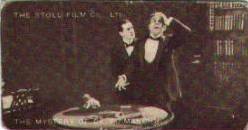
No. 13
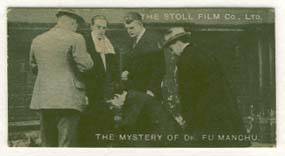
No. 14
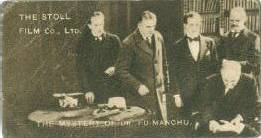
No. 15
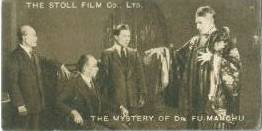
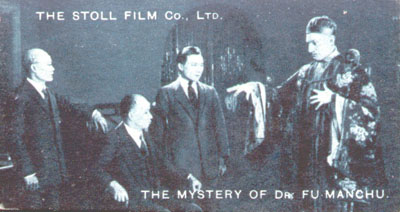
No. 16

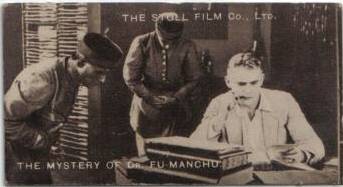
No. 17
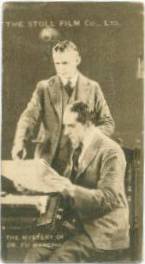
No. 18

No. 19
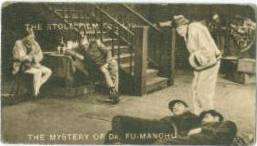
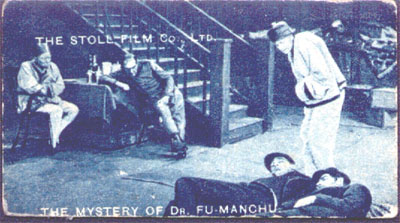
No. 20
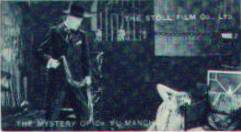
No. 21
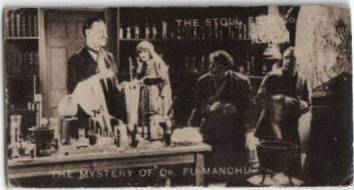
No. 22

No. 23

No. 24
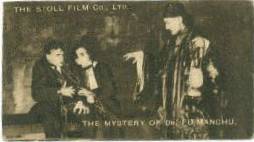
No. 25
|
|
| Production Company: |
Stoll |
| Producer/Director: |
A. E. Coleby
|
| Scenario by: |
A. E. Coleby & Frank Wilson |
| Cameraman: |
D. P. Cooper (& Phil Ross) |
| Editor: |
H. Leslie Brittain |
| Art Director: |
Walter H. Murton |
| Release date: |
10 September 1923 |
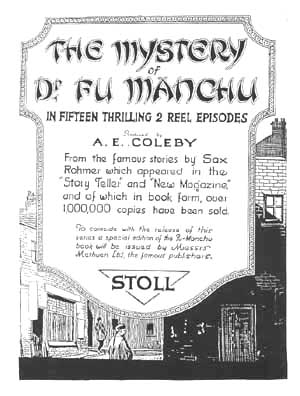
|
Episodes: |
Length: |
| 1 |
The Scented Envelopes |
(2400 feet) |
| 2 |
The West Case |
(1800 feet) |
| 3 |
The Clue of the Pigtail |
(1700 feet) |
| 4 |
The Call of Siva |
(1700 feet) |
| 5 |
The Miracle |
(1712 feet) |
| 6 |
The Fungi Cellars |
(1630 feet; BFI 1457 feet) |
| 7 |
The Knocking on the Door |
(2228 feet) |
| 8 |
The Cry of the Nighthawk |
(1773 feet; BFI 1623 feet) |
| 9 |
Aaron's Rod |
(1862 feet) |
| 10 |
The Fiery Hand |
(2174 feet; BFI 2008 feet) |
| 11 |
The Man with the Limp |
(2000 feet) |
| 12 |
The Queen of Hearts |
(1750 feet; BFI 1771 feet) |
| 13 |
The Silver Buddha |
(1570 feet; BFI 1484 feet) |
| 14 |
The Sacred Order |
(1700 feet; BFI 1629 feet) |
| 15 |
The Shrine of Seven Lamps |
(1500 feet; BFI 1610 feet) |
| Players: |
|
|
| Harry Agar Lyons |
Dr. Fu-Manchu |
|
| Fred P. Paul |
Nayland Smith |
|
| H. Humberston Wright |
Dr. Petrie |
|
| Joan Clarkson |
Karamaneh |
|
| Frank Wilson |
Inspector Weymouth /
James Weymouth |
|
| Pat Royale |
Aziz |
[Episodes 6, 10] |
| Wingold Lawrence |
Frank Norris West |
[Episode 2] |
| Stacey Gaunt |
Lord Southery |
[Episode 5] |
| Charles Vane |
Sir Crichton Davey |
[Episode 1] |
| Percy Standing |
Abel Slattin |
[Episode 9] |
| Ernest Spalding |
Shen-Yan |
[Episode 3] |
| Napier Barry |
Henderson |
[Episodes 5] |
| Julie Suedo |
Zarmi |
[Episodes 11, 12] |
| Robert English |
Sir John Astley |
[Episode 1] |
| Booth Conway |
Mordain |
[Episode 1] |
| Austin Leigh |
valet |
[Episode 5] |
| H. Cundall |
Forsyth |
[Episode 8] |
| D. Bland |
Logan |
[Episode 12] |
| Fred Raynham |
Sir Frazer |
[Episode 12] |
| Madge Royce |
? |
[Episode 12] |
| E. Lewis Walter |
Salaman |
[Episode 13] |
| Laurie Leslie |
dacoit |
[Episode 14] |
| H. Manning |
Mandarin |
[Episode 14] |
| Percy Clarbour |
Inspector Wills |
[Episode 14] |
Film historian John Soister's latest book, UP
FROM THE VAULTS: RARE THRILLERS FROM THE 20s & 30s (McFarland &
Company), should be out in February or March of 2004. The book contains the most
extensive discussion of the Stoll movies to date and is highly recommended. A brief
excerpt follows:
|
The Mystery of Dr. Fu
Manchu (erroneously referred to as “The
Mysteries” by some of the contemporary British trade magazines)
was a collection of 15 semi-autonomous two-reelers, adapted by director
A.E. Coleby and Frank Wilson from Sax Rohmer’s ever growing literary
output. The studio admitted
that the scenarios had been pretty much lifted from the author’s
original short stories (published as far back as October 1912 in the Story
Teller magazine, the New Magazine, Collier’s, et
al), and Kinematograph Weekly
(26 April 1923) advised interested exhibitors that the studio heads…
are
spending many thousands of pounds upon what they consider to be the greatest publicity scheme yet devised.
Hundreds of the finest bill-posting sites in the United Kingdom
have been secured to herald the series; Tube lifts and Tube stations
will be utilised; advertisements will appear in newspapers all over
the country, and Methuen and Co., Ltd., is publishing special editions
of The Mystery of Dr. Fu Manchu, The Devil Doctor, and The Si-Fan
Mysteries, from which the series
has been adapted. (p. 121)
In addition to Stoll’s attempts at having Harry Lyons’ gaunt
visage staring down at tube patrons and pedestrians everywhere, other
industry publications recommended that theater displays be jazzed up via
purple lighting, Chinese lettering on upright narrow panels, and
attendants attired in Chinese costumes.
The Methuen and Co. volumes were likewise touted as lobby
decoration, as were the sundry pertinent copies of >Story
Teller magazine, replete with lurid cover art.
(The exhibitors were also rather shamelessly exhorted to tie
in with The Eye of Siva, a Fu
Manchu play that was making some noise on the West End at that time.)
The scope (and cheek) of such an aggressive publicity campaign is
best appreciated when one recalls that The
Mystery of Fu Manchu was a series of short subjects, normally meant
to augment - not overshadow - the current feature film.
Copyright © 2003 John Soister -- Used with
permission |
For John Soister's detailed descriptions of
each of the episodes--including each episode's cast and plot summary, click
here.
1924: The Further Mysteries of Fu Manchu
This title was originally advertised as "The
Mystery of Dr. Fu Manchu (Second Series)."
(8 two-reel episodes)
| Production company: |
Stoll |
| Director: |
Fred Paul |
| Adaptation: |
Fred Paul |
| Cameraman: |
Frank Canham |
| Art Director: |
Walter W. Murton |
| Release date: |
7 August 1924 |
|
Episodes: |
Length: |
| 1 |
A Midnight Summons |
(1791 feet) |
| 2 |
The Coughing Horror |
(1800 feet; BFI 1871 feet) |
| 3 |
Cragmire Tower |
(2040 feet; BFI 1714 feet) |
| 4 |
The Green Mist |
(1734 feet) |
| 5 |
The Café de l'Egypte |
(2270 feet) |
| 6 |
The Golden Pomegranates |
(2100 feet; BFI 2094 feet) |
| 7 |
Karamenah |
(2366 feet) |
| 8 |
Greywater Park |
(2390 feet) |
| Players: |
|
|
| Harry Agar Lyons |
Dr. Fu-Manchu |
|
| Fred P. Paul |
Nayland Smith |
|
| H. Humberston Wright |
Dr. Petrie |
|
| Dorinea Shirley |
Karamaneh |
|
| Frank Wilson |
Inspector Weymouth |
|
| George Foley |
Hagar |
[Episode 3] |
| Fred Morgan |
Antonio Strozza |
[Episode 2] |
| Julie Suedo |
Zarmi |
[Episode 6] |
| Henry Wilson |
? |
[Episode 2] |
| Harry Rignold |
the Coughing Horror |
[Episode 2] |
| Johnny Butt |
Farmer |
[Episode 2] |
| Rolf Leslie |
Van Room |
[Episode 3] |
| Fred Hearn |
waiter |
[Episode 6] |
The above information for the three Stoll
productions combines material from standard references (principally the British Film
Institute Catalog) with additions and corrections (the result of more specialized
research) from Victor Berch and John Soister. The lengths marked BFI are from the British
Film Institute Catalog; the other measurements were supplied by John Soister from other
sources.
|
Directed by Rowland V. Lee
35mm, 80 min.
Paramount Pictures.
Screenplay: Florence Ryerson, Lloyd Corrigan.
Based on the
story by Sax Rohmer.
Cinematography: Harry Fischbeck.
Editor: George Nichols, Jr.
Cast: Warner Oland, O.P. Heggie, Jean Arthur, Neil Hamilton, Claude
King, William Austin, Charles A. Stevenson, Evelyn Selbie, Noble Johnson,
Tully Marshall.
O.P. Heggie.
A silent and an "All Talking" sound version were
released simultaneously.
 The opening music.
The opening music.
"The least known of all the sound Fu Manchu
pictures are those that ushered the character created by author Sax Rohmer into the talkie
era. With THE MYSTERIOUS DR. FU MANCHU, Paramount launched a three-picture series in which
the title role was played by Warner
Oland , soon to achieve greater fame as
detective Charlie Chan. The film recounts the beginnings of the doctor's life of crime:
the deaths of his wife and son during the Boxer Rebellion drives Dr. Fu Manchu to
kill
off, one by one, the British colonialists who put down the Rebellion, using what a
contemporary reviewer called "diabolical cunning and fiendish methods." The aura
of mystery and menace comes via director Rowland V. Lee, who would achieve similar effects
in later thrillers such as SON OF FRANKENSTEIN (1939). "
-- UCLA Film and Television Archive
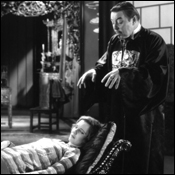
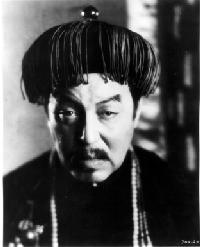 |
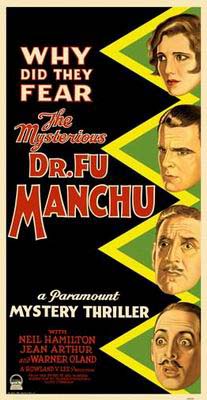
A Paramount Mystery Thriller
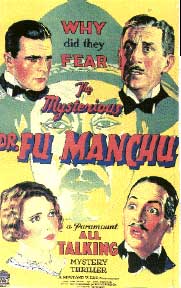
A Paramount All Talking Mystery Thriller
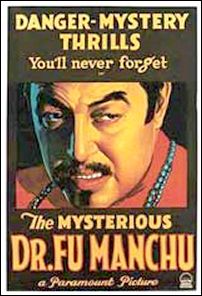
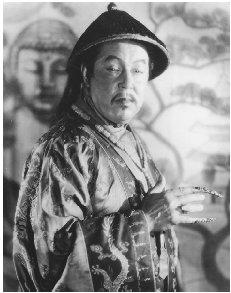 |
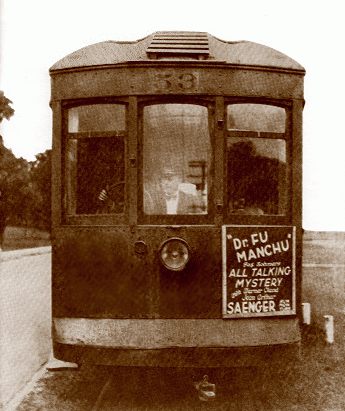
Streetcar 53 on the
waterfront line of coastal Mississippi, probably Gulfport, with an
advertisement for "Dr. Fu Manchu" running at the Saenger Theatre in nearby
Biloxi. The photo is from Southern Traction,
a 1983 magazine about
streetcars in the south, and is
credited to a 1975 Mississippi Power Company
publication. --Submitted by Bill Hooper
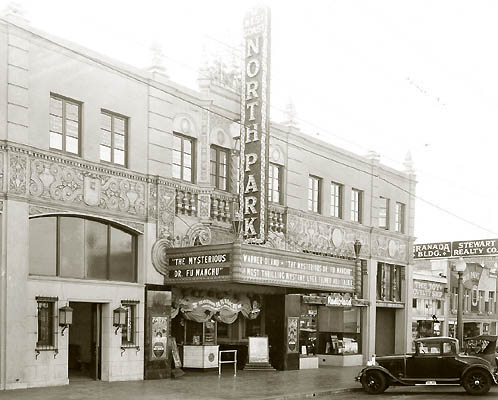
North Park in San Diego

Lowes in Cleveland
|
1930? Den mystiske Dr. Fu Manchu
Danish release. An eight page program was given to Danish movie patrons.
It was about 7 x 9 inches. There were four additional photos within. |
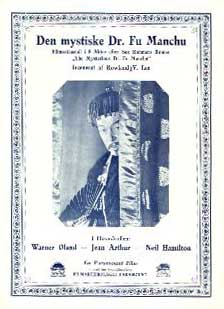 |
|
|
A Paramount Picture
Starring Warner Oland,
O. P. Heggie,
Jean Arthur, and
Neil Hamilton.
When this movie opened at the Seattle Paramount Theater, a three
piece mandolin orchestra played.
. |
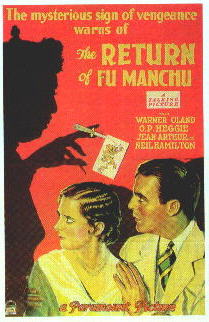 |
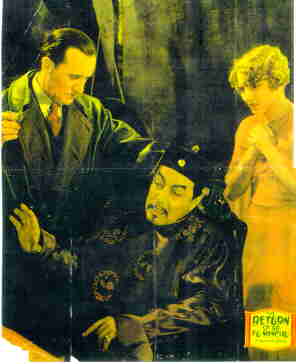 |
The poster art above was used in 1996 on a
French Omnibus edition. Compare
Lobby card for The Return of Fu Manchu |
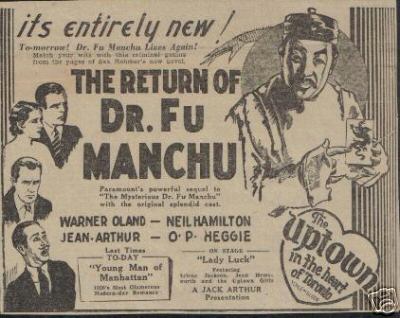 |
 |
"Warner Oland's fourth appearance as Fu Manchu in 'Murder Will Out,' a comedy
sketch which formed a segment in PARAMOUNT ON PARADE, one of those all-star revues the
studios were so fond of. The film was shot in both black and white and Technicolor.
Unfortunately, the color segments no longer survive. Fortunately, the B&W segments,
including 'Murder Will Out,' do. In this, Clive Brook as Sherlock Holmes is teamed with
William Powell as Philo Vance against Oland's Devil Doctor. I seem to remember a gunshot
and a blackout and chase and the segment lasted but a scant few minutes." -- Leonard
P. Gray, Email (July 19, 1998)
Paramount on Parade was discussed in detail in a letter from Stephen
Shutt published in The Rohmer Review No 13. He quotes the
following passage from "Paramount: The Fantasy Years --- 1929-39" in the
magazine "Gore Creatures #22."
"Oland did a comic cameo as Fu Manchu for Paramount's 1929 Technicolor-tinted
extravaganza Paramount on Parade. Coupled in a satiric murder mystery sequence with
Sherlock Holmes (Clive Brook) and Philo Vance (William Powell), confessed killer Fu Manchu
is impelled to shoot the astute detectives in order to convince them that he is a real
murderer!"
The following additional information is from a Jeanette MacDonald & Nelson Eddy site:
Released April 19, 1930. A revue in 20 parts. Black and white film with two-strip
Technicolor sequences.
Eleven directors: Dorothy Arzner, Victor Heerman, Ernst Lubitsch, Edward
Sutherland, Otto Brower, Lothar Mendes, Edmund Goulding, Rowland V. Lee, Victor
Schertzinger, Frank Tuttle, Edwin H. Knopf. Supervised by: Elsie Janis. Dance
ensembles: David Bennett. Photography: Harry Fischbeck and Victor Milner. Set
design: John Wenger.
In the first few years of sound film, each major studio hastily constructed a revue to
show off their major stars talking, and sometimes singing and dancing. The most stylish of
these smorgasbords was Paramount on Parade. The vaudeville format permitted
versions in many languages featuring sequences with the stars of the targeted country. The
American cast included Maurice Chevalier, Richard Arlen, Jean Arthur, William Austin,
George Bancroft, Clara Bow, Evelyn Brent, Mary Brian, Clive Brook, Virginia Bruce, Nancy
Carroll, Ruth Chatterton, Gary Cooper, Cecil Cunningham, Leon Errol, Stuart Erwin, Kay
Francis, Skeets Gallagher, Harry Green, Mitzi Green, James Hall, Phillips Holmes, Helen
Kane, Dennis King, the Abe Lyman Band, Fredric March, Nino Martini, Mitzi Mayfair, David
Newell, Jack Oakie, Warner Oland, Zelma O'Neal, Eugene Pallette, Joan Peers, William
Powell, Charles "Buddy" Rogers, Lillian Roth, Stanley Smith, and Fay Wray. The
only major Paramount star not included was Jeanette. (Newcomer Claudette Colbert wouldn't
achieve stardom until May, 1930 in The Big Pond with Chevalier.)
In Part Four of his discussion of "Holmes on Screen," Damian
Magee notes of "Murder Will Out," that "This was the first time that
Holmes died on screen."
1931: Daughter
of the Dragon
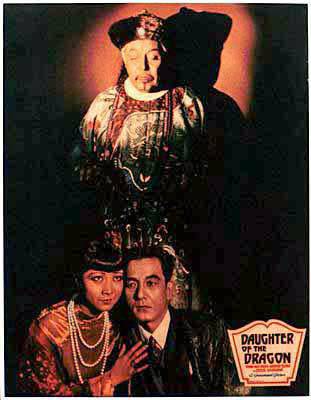

La Hija del Dragón
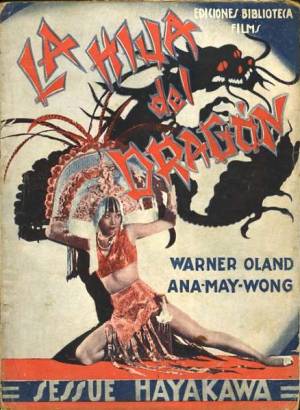
December, 1931, Brazilian movie magazine
9 x 12-1/2 inches, 36 pages
 |
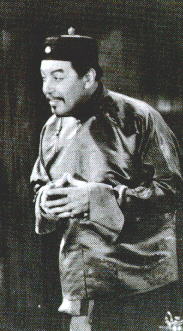 |
|
|
Directed by Lloyd Corrigan, 70 min. Sound. Cast (in alphabetical order)
Warner Oland as Dr. Fu Manchu; Anna May Wong as Princess Ling Moy; and Sessue Hayakawa as
Ah Kee. Also: Frances Dade, Lawrence Grant, Holmes Herbert, and Nella Walker.
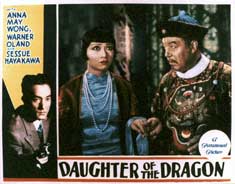
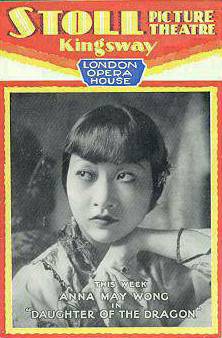
Vowing to avenge her dying father, Ling Moy becomes entangled with Ah Kee (Sessue
Hayakawa), a Scotland Yard investigator. Notably, this is the only film featuring Anna May
Wong and Sessue Hayakawa in starring roles together, and was the first sound film Hayakawa
did in Hollywood.
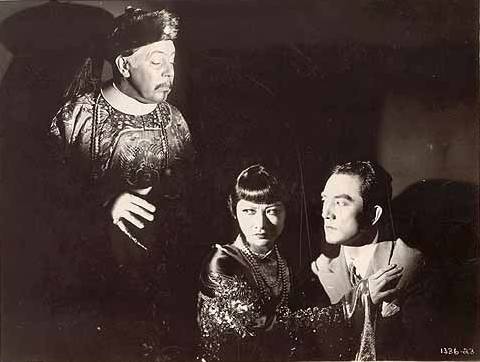
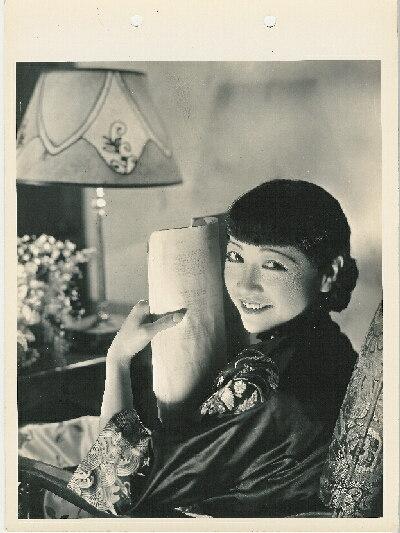
A studio publicity shot with a caption on the back:
"Home Study -- Anna May Wong spends an evening at her
Hollywood apartment
studying her lines from the script of Paramount's Daughter of the Dragon."
Two Hearts in Wax Time.
1935.
Short musical fantasy, 20 minutes
Also released as The Department Store
USA:17 min
Technicolor
Mono, Western Electric Sound System
|
Jay Eaton |
.... |
Mannequin Dresser (uncredited) |
|
Sam McDaniel |
.... |
Deck Attendant (uncredited) |
|
Shirley Ross |
.... |
Shirley, the Mannequin (uncredited) |
|
Syd Saylor |
.... |
Mannequin Dresser (uncredited) |
|
Gus Shy |
.... |
Inebriated Custodian (uncredited) |
|
Jurmann Walter |
.... |
Original Music/Soundtrack |
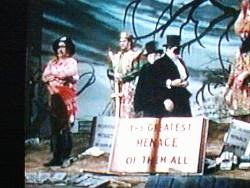 Screen capture by Stuart Gardner
Screen capture by Stuart Gardner
This is a short musical where an employee in a department store
works with the mannequins, drinks
too much, and sees the mannequins come to life
in the store's display window. The display is
"The Greatest Menace
of Them All" and
includes Bluebeard , Frankenstein, Blackbeard
and Fu Manchu.
Jurmann Walter wrote the original music. He was also
responsible for the music in the Marx Bothers' "A Day at the Races" and "A
Night at the Opera." He also wrote but was not credited for the "Love Song of
Tahiti" in the Clark Gable version of "Mutiny on the Bounty."
In the course of the film, Fu Manchu
sings a couple of lines:
"I am the man called Fu Manchu
I am a greater menace than you
I kill just to have something to do"
The short is in color and is about 10 minutes long.
--First reported by Brian MacDonald


Movies - Part Two
Copyright © 1997 - 2004 Lawrence Knapp. All rights reserved.